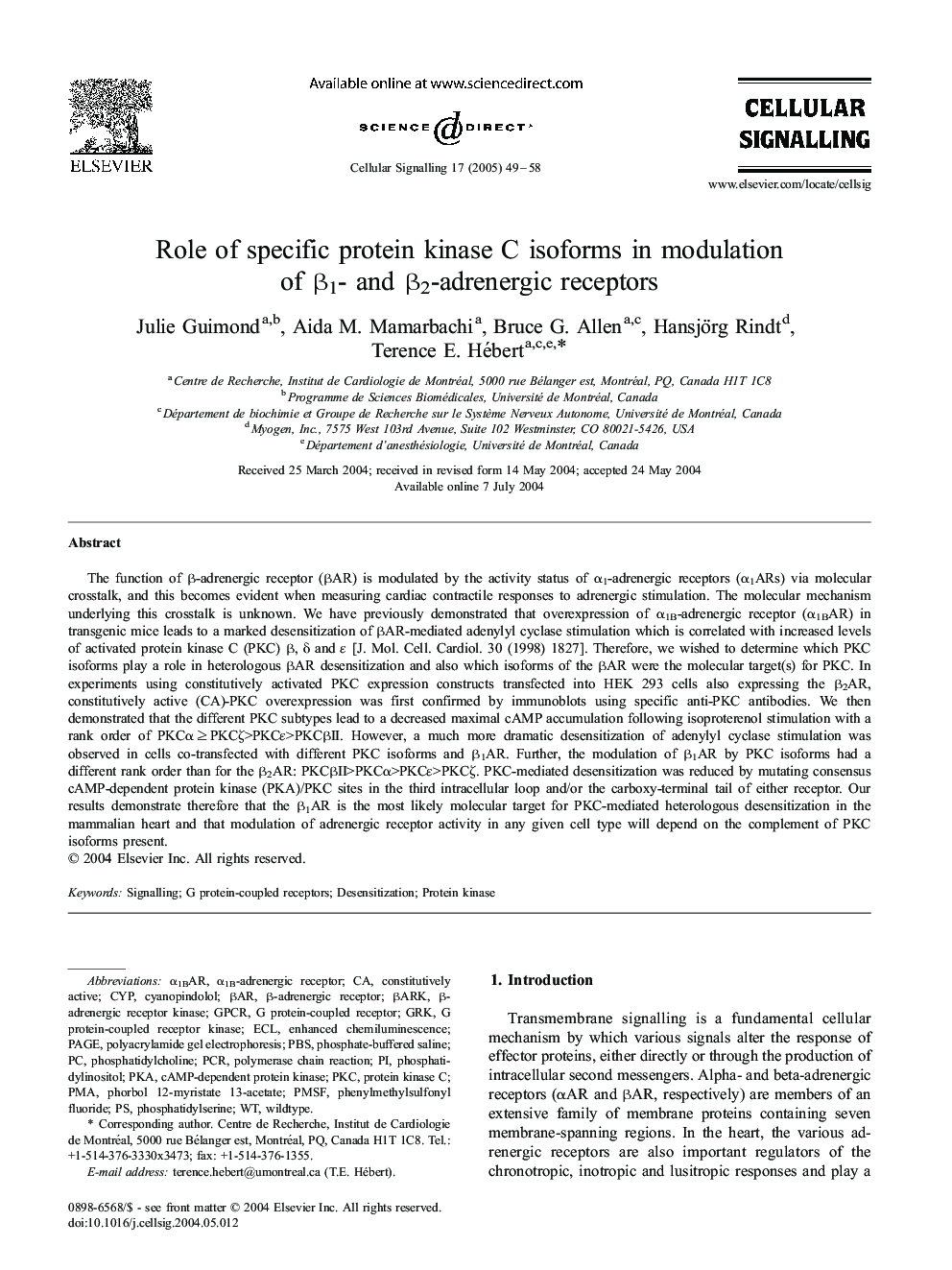| کد مقاله | کد نشریه | سال انتشار | مقاله انگلیسی | نسخه تمام متن |
|---|---|---|---|---|
| 10816547 | 1058578 | 2005 | 10 صفحه PDF | دانلود رایگان |
عنوان انگلیسی مقاله ISI
Role of specific protein kinase C isoforms in modulation of β1- and β2-adrenergic receptors
دانلود مقاله + سفارش ترجمه
دانلود مقاله ISI انگلیسی
رایگان برای ایرانیان
کلمات کلیدی
PKCα1B-Adrenergic receptorβ-adrenergic receptor kinaseβARKβARphorbol 12-myristate 13-acetateGRKGPCRECLpKaPAGEPBSCyPPMSFG protein-coupled receptor kinase - G پروتئین گیرنده کینازG protein-coupled receptors - G گیرنده های پروتئینی همراهPMA - LDC هاpolyacrylamide gel electrophoresis - الکتروفورز ژل پلی آکریل آمیدenhanced chemiluminescence - بهبود شیمیایی لومنconstitutively active - سازنده فعال استcyanopindolol - سایانوپندولولSignalling - سیگنالینگ phosphatidylinositol - فسفاتیدیل اینوزیتولphosphatidylcholine - فسفاتیدیل کولینPhosphatidylserine - فسفاتیدیلسرینphenylmethylsulfonyl fluoride - فنیل متیل سولفونیل فلورایدPhosphate-buffered saline - محلول نمک فسفات با خاصیت بافریwildtype - نوع وحشیpolymerase chain reaction - واکنش زنجیره ای پلیمرازPCR - واکنش زنجیرهٔ پلیمرازProtein kinase - پروتئین کینازProtein kinase C - پروتئین کیناز سیcAMP-dependent protein kinase - پروتئین کیناز وابسته به cAMPDesensitization - کاهش حساسیتβ-Adrenergic receptor - گیرنده β-adrenergicG protein-coupled receptor - گیرندههای جفتشونده با پروتئین جی
موضوعات مرتبط
علوم زیستی و بیوفناوری
بیوشیمی، ژنتیک و زیست شناسی مولکولی
زیست شیمی
پیش نمایش صفحه اول مقاله

چکیده انگلیسی
The function of β-adrenergic receptor (βAR) is modulated by the activity status of α1-adrenergic receptors (α1ARs) via molecular crosstalk, and this becomes evident when measuring cardiac contractile responses to adrenergic stimulation. The molecular mechanism underlying this crosstalk is unknown. We have previously demonstrated that overexpression of α1B-adrenergic receptor (α1BAR) in transgenic mice leads to a marked desensitization of βAR-mediated adenylyl cyclase stimulation which is correlated with increased levels of activated protein kinase C (PKC) β, δ and ε [J. Mol. Cell. Cardiol. 30 (1998) 1827]. Therefore, we wished to determine which PKC isoforms play a role in heterologous βAR desensitization and also which isoforms of the βAR were the molecular target(s) for PKC. In experiments using constitutively activated PKC expression constructs transfected into HEK 293 cells also expressing the β2AR, constitutively active (CA)-PKC overexpression was first confirmed by immunoblots using specific anti-PKC antibodies. We then demonstrated that the different PKC subtypes lead to a decreased maximal cAMP accumulation following isoproterenol stimulation with a rank order of PKCαâ¥PKCζ>PKCε>PKCβII. However, a much more dramatic desensitization of adenylyl cyclase stimulation was observed in cells co-transfected with different PKC isoforms and β1AR. Further, the modulation of β1AR by PKC isoforms had a different rank order than for the β2AR: PKCβII>PKCα>PKCε>PKCζ. PKC-mediated desensitization was reduced by mutating consensus cAMP-dependent protein kinase (PKA)/PKC sites in the third intracellular loop and/or the carboxy-terminal tail of either receptor. Our results demonstrate therefore that the β1AR is the most likely molecular target for PKC-mediated heterologous desensitization in the mammalian heart and that modulation of adrenergic receptor activity in any given cell type will depend on the complement of PKC isoforms present.
ناشر
Database: Elsevier - ScienceDirect (ساینس دایرکت)
Journal: Cellular Signalling - Volume 17, Issue 1, January 2005, Pages 49-58
Journal: Cellular Signalling - Volume 17, Issue 1, January 2005, Pages 49-58
نویسندگان
Julie Guimond, Aida M. Mamarbachi, Bruce G. Allen, Hansjörg Rindt, Terence E. Hébert,